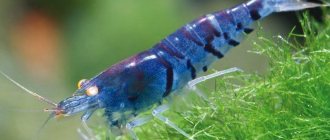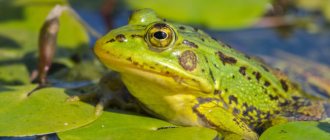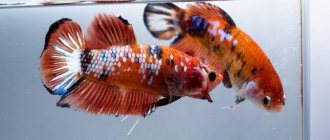Swordtails are considered one of the most unpretentious and popular fish among aquarists. Xiphophorus helleri belongs to the poeciliaceae family. They quickly adapt and survive in different environments. The swordtail is able to reproduce at home. The fish is peaceful, capable of living together, some males can be aggressive towards their relatives. To obtain high-quality offspring in the wild, the female swordtail spawns in the spring. In an aquarium, the swordtail is capable of breeding all year round.
Preparation for reproduction
Successful breeding of swordtails at home is impossible without proper training of producers. When selecting pairs, all weak and sick fish should be discarded. Strong, viable fry can only be obtained from completely healthy individuals.
The optimal age for breeding is 6-8 months and older. Some females are capable of bearing offspring at the age of 3-4 months, but in most cases, sexual maturity in representatives of this species occurs at 5-6 months. Fish older than 4-5 years should not be allowed into breeding. Producers that are too old produce weak and few offspring.
Housing conditions have a great influence on the number and viability of fry. The water must be clean, without excess nitrogen compounds, and contain enough oxygen. To ensure these conditions, the aquarium is equipped with a filter and an aeration system. It is necessary to replace 1/4 of the aquarium volume with fresh water weekly. In this case, acidity should be maintained at 7-8, and hardness at 10-12°.
An increase in temperature stimulates fish to begin reproduction, so during the period of breeding, the water temperature should be maintained at 24-25°C. It should be taken into account that the sex of future fry depends on the water temperature during the female’s pregnancy. At lower values, more females are born, at higher values, males are born.
To get healthy offspring, it is important to feed the breeders properly. The diet should be varied and include enough animal protein. For this purpose, the fish are regularly fed live and frozen food - bloodworms, daphnia, cyclops, etc. The diet should also contain food of plant origin, made from algae. You should not feed fish expired, poor-quality, mold- or pest-affected food.
Sex differences
The fish belong to the Petsiliev family. Their body is elongated, somewhat compressed at the sides. Due to the fact that they feed mainly from the water surface, they have an upturned mouth.
The sex of newborn swordtails is difficult to determine. They do not have pronounced sexual characteristics. They begin to appear 3 to 6 months after birth.
However, individual females are able to begin reproducing at the age of 3 - 4 months.
The differences between female and male swordtails are visible to the naked eye.
It is not difficult to distinguish males and females in adulthood. The male has a long outgrowth; it is compared to a sword located on the tail. The fish owe their name to him. The fact that the male specimen has a pointed and narrow anal fin also helps determine the sex.
Females are paler compared to males. Their anal fins are wide and rounded. In males they are elongated, tube-shaped. They carry out fertilization with them, right in the belly of females.
In length, the fish reach sizes of 8–10 cm. At the same time, males are smaller than females, on average by 2 cm (adults).
Swordtails are fish that can change their gender during their lives. There are about 500 such species in nature. This metamorphosis is possible due to the lack of chromosomes that are responsible for belonging to a particular sex.
However, the main factor in the transformation is the threat of extinction of the local group. Swordtails, changing, are trying to save the population.
If the male dies, after a certain period of time, any female may turn into a male fish. But the offspring produced using the replacement female will produce only females.
Fish that have changed their sex to male will subsequently not be able to be reborn, and their ability to reproduce offspring disappears. The former female never gives birth.
Pregnancy period
After mating, pregnancy occurs. It can be determined by a number of characteristic features.
Signs of pregnancy
To determine pregnancy, you should look at the female's belly. In a pregnant individual, it is large in size and round in shape; the transition from the head to the abdomen is sharp, in the form of a step, which is why the head appears smaller and more graceful than that of non-pregnant females. Before childbirth, the shape of the abdomen becomes rectangular, and a protrusion appears near the cloaca.
A dark spot appears in front of the anal fin of the fish that bears eggs. In non-pregnant females this area is light. As the eggs develop, the spot enlarges and becomes darker.
How long does pregnancy last
The duration of pregnancy varies for different females and depends on a number of factors:
- temperature and other water parameters;
- duration of daylight hours and lighting intensity;
- quality and composition of the diet;
- the age and health of the female.
On average, pregnancy in swordtails lasts 4-6 weeks.
Behavior before childbirth
The behavior of a pregnant female swordtail changes before giving birth. She loses her appetite, begins to worry, rushes around the aquarium, tries to hide in the thickets of plants. The fish tends to stay near the bottom behind the decorations or in the corner of the aquarium, where it will not be disturbed by other fish. If such signs appear, the female should be placed in the spawning tank as soon as possible in order to avoid eating the born fry by other inhabitants of the aquarium.
The spawning tank is a small aquarium (10-20 liters), where the fry will be raised in the future. When transplanting a female into a separate tank, it must be filled with water from a common aquarium to prevent stress in the fish. A sufficient number of bunches of plants (for example, riccia) floating on the surface of the water should be placed in the spawning tank, in which the born fry will hide.
Birth of fry
Typically, spawning of swordtails begins in the morning. Childbirth lasts from several hours to days. The number of fry that swordtails give birth to at one time can reach 200 pieces. The female gives birth to 1 fry with short breaks. Once born, the fry sink to the bottom or rise to the surface of the water and hide in the thickets of plants. After the end of the birth process, the female must be moved back to the general aquarium as soon as possible so that she does not eat her own offspring.
Mating of swordtails
Swordtails are among the viviparous aquarium fish with internal fertilization. In the male, the anal fin is transformed into a gonopodium (copulation organ). It looks like a narrow and elongated tube.
During mating, the male inserts the gonopodium into the female's cloaca, after which the reproductive products are transferred. They can remain in the female body for quite a long time.
The female is capable of producing offspring 4-5 times after one mating. Even in the case when the male lives separately.
Care of offspring
Swordtail fry need proper care from birth. Their future health and life expectancy depend on the conditions in which they are kept and what food they eat. Proper care of the fry is also necessary in order to avoid their death in the first days of life.
Setting up a spawning tank
For the first time after birth, the fry are kept in a spawning tank. Small-leaved plants (in pots and free-floating) are placed in it, in which the fry can hide. No soil is placed on the bottom. A lamp is placed above the pond. Internal equipment includes a heater that maintains the temperature at 24-25°C and an aeration system. The filter is not installed due to the risk of fry getting inside the device.
On a note! To clean the spawning tank from food debris, you can place a couple of snails.
What to feed swordtail fry
Swordtail fry grow quickly and require a large amount of food. With a lack of nutrients, the fish grow small, with skeletal defects and dull color. In the first days of life, the fry should be fed 4 times a day. After reaching 2 months of age, the fish are transferred to three feedings a day.
Fry can be given:
- Artemia nauplii;
- rotifers;
- microworm;
- cut pipeweed;
- Cyclops;
- dried daphnia ground into powder.
These types of food can be purchased at a pet store or mixed yourself. Purchased live food must be thoroughly washed and inspected for the presence of parasites that may pose a danger to the fry. You should not feed dead or sick invertebrates to fish. Food of animal origin can be given to fish in frozen form, but live invertebrates are preferable for fry.
In the last century, aquarists often used hard-boiled egg yolk to feed young fish. Currently, it is not recommended to give this type of food to fry: it heavily pollutes the water and provokes the proliferation of harmful bacteria. Instead, it is better to use ready-made industrial food for young aquarium fish, as well as feed mixtures for adult fish, ground into powder.
In addition to animal feed, the fry's diet should contain plant products. You can give your fish ready-made flakes containing fiber with the addition of spirulina. Spirulina is necessary for fish for normal growth and the formation of bright colors.
When to replant
While raising the fry, it is necessary to ensure that they always have enough free space for swimming. Fish raised in cramped conditions are often small in size and suffer from curvature of the spine and defects in their fins. Therefore, as swordtails grow, they are periodically sorted and placed in separate containers. The frequency of replanting depends on the size of the spawning tank and the number of fry living in it.
Young fish can be placed in a community aquarium when the fish have reached a sufficient size so that larger neighbors cannot eat them, and also when they are ready to switch to feeding on adult food. This usually occurs at the age of 3-4 months. At the same time, the sex of the fry can be determined and the groups required by the breeder can be formed depending on their morph.
Feeding the young
It is clear how swordtails reproduce, but it is important to properly feed the fry. The period from the first seconds of life to a week of age is the most important in feeding young animals. On these days, it is necessary to leave the light on during the dark and give the young fish plenty of complementary foods with a complete chemical composition, otherwise the fry may grow into weak individuals. Microworms (easy to dilute in grated carrots), crushed oligochaetes, rotifers, and cyclops are suitable as the first food. Live food can be replaced with industrial mixtures. Such concentrates combine all the vitamins and nutrients so necessary for young animals. Also, when breeding aquarium swordtail fish, chicken yolk, regular yogurt, and a special omelet are used for feeding.
As the first food for fry, you can use universal store-bought mixtures for fry.
You can feed the fish with mild cheese. The product is grated on a fine grater and sent in small portions to the aquarium with the fry. Too much feed can spoil the water.
Powdered milk acts as a highly nutritious protein food. You can cook it yourself. A plate of milk is placed in a water bath and evaporated until a dry residue is obtained. The powder is poorly soluble in water and is accessible to fish.
Chicken yolk as food is first ground, a little water taken from the hatchling is added and poured into the fry.
The yolk is an excellent food for bacteria and it quickly pollutes the water, so this food can only be used in case of force majeure. Young fish will not be able to live for long in rotten water, and changing water in large quantities is stressful for the fish.
You can use yogurt to feed the fry. A little curdled milk is poured into boiling water to curdle the casein. The washed protein lumps are placed in a net and placed in the aquarium, shaking slightly. The advantage of this food is that it does not spoil the water. The food should be stored in the refrigerator, but no more than 3-4 days.
If born in a community aquarium
If the owner did not notice changes in the behavior of the female before giving birth and did not remove her, and the fry were born in the general aquarium, they will become easy prey for the rest of its inhabitants, especially if they have a bright red or orange color. Therefore, it is not recommended to breed swordtails in a community aquarium. If newborn fry are found in the aquarium, it is necessary to catch them as soon as possible and transplant them into a spawning tank, where they will subsequently be raised.
If it is not possible to place the fry, you should place in the general aquarium as many dense plants as possible, including floating ones (for example, bunches of riccia), in which the fish can hide. The fish will have to be fed more often, while food for adults is placed in a familiar feeder, and food for fry is evenly distributed over the surface of the water. It is necessary to ensure that the fry have enough food and that it is not all eaten by the adult fish. However, even after taking all possible measures, most of the fry will be eaten by larger neighbors, and only a few individuals will survive.
Causes of infertility
Mating of swordtails does not occur under poor conditions. Infertility can be caused by poor or monotonous diet. These fish often refuse to reproduce in the following cases:
- severe and constant stress caused by overly active, aggressive and large neighbors in the aquarium;
- sudden changes in water parameters in the tank;
- absence of algae and plants in the aquarium;
- various external stimuli.
Often offspring do not appear when the producers are ill or have some genetic defects.
Compatibility with other fish
Old males can attack other fish, but this depends on the individual. Some live quite peacefully, while others become violent. Aggression is promoted by cramped aquariums without plants. What you definitely shouldn't do is keep two or more males in one aquarium. This leads to guaranteed fights. Who do they get along with? With viviparous animals: guppies, platies, mollies. They get along well with a variety of spawning fish: angelfish, gouramis, neons, and irises. But it’s better not to keep them with gold ones. Gold requires colder water, and swords are restless neighbors.
Sex ratio
The numerical sex ratio was considered when selecting ornamental fish for cultivation from the natural environment. More research in this area has been carried out on Xiphophorus maculatus than on the swordtail X. helleri (Campton 1989). However, based on the many color variations of swordtails that form hybrids between Xiphophorus maculatus and X. helleri, information has accumulated about the mechanisms of its control. According to Basolo (1990), the sex of Xiphophorus maculatus is determined by the W, X, and Y genes. These genes produce three female genotypes (WX, WY, and XX) and two male genotypes (YY, XY). In swordtails, sexual determination is assumed to be complex, polygenetic and interactive (Basolo 1990). Sex determination of genes shows several chromosomes that interact with each other, and the cumulative expression of genes determines the sex of the fish. An overview of the sex ratios of the five swordtail variations is presented in Table 2. All variations were cultured in aquariums with a diameter of 3.66 meters in one fish farm under general conditions. Observations of sex ratios have shown differences between breeds from an equivalent ratio (1 female/1 male) to a ratio of 4 females/1 male. An even greater asymmetry in the distribution of 9 females/1 male was observed among some farmers. Obviously, the sex ratio is partly related to the breed of the swordtail.
| Aquarium | Variation | Female |
The photo shows a male and female swordtail
Perhaps the most important rule to follow when breeding swordtails is concern for the survival of the young. Unfortunately, the producers eat their own offspring, and given that the fry of swordtails are quite large in size and brightly colored, this process simply turns into extermination. In nature, swordtails never see their offspring, since the fry is immediately carried away by the current. In the aquarium, the parents mistake the fry for food.
To preserve the offspring, I plant the aquarium densely with aquarium plants. Plants are placed at the bottom of the aquarium, in the water column and especially densely on the surface. Thus, the fry are provided with shelter “from evil parents” and most of the fry survive.
Also, to preserve the offspring, you can use special aquariums, which are designed like a funnel - the female remains in the funnel, and the swept juveniles fall out of the funnel into the spawning aquarium. Thus, initially the absence of contact between the breeder and the fry is ensured.
The third option for preserving offspring is spawning spawners immediately after spawning. This option is simple, but requires attention and timeliness from the aquarist.
Why don't they grow?
Many aquarists purchase juveniles that subsequently do not grow at all. There are several factors that negatively affect the development of fish:
- small volume of the aquarium (it should be at least 35 liters for one individual);
- poor care, infrequent water changes, which results in the formation of a lot of ammonia;
- The diet does not include plant foods.
We invite you to familiarize yourself with what kind of bird Guinea fowl photo
Such situations should be corrected immediately. If a little time has passed, then Swordtails can still grow, sometimes they remain small.
The further task is to preserve the fry
Born babies are desirable food for many aquarium inhabitants, not excluding their own parents. Therefore, the ability to hide is their main task. To solve this problem, you need to select appropriate plants and the interior design of the aquarium.
The following will successfully cope with the role of protective structures:
- Vallisneria;
- Echinodorus;
- cryptocoryne;
- Riccia.
Duckweed will improve the aquatic environment, and elodea will saturate it with oxygen.
Hiding in the thickets, the fry quickly gain strength and grow up. By three months they acquire sexual characteristics, and by six months they are ready for independent reproduction.
Fertility
Fecundity of X. helleri is approximately 242 juveniles per female (Breder and Rosen 1966); however, X. helleri broods average 30 fry per female. Among viviparous fish, there is a relationship between fecundity and body length. Fecundity of X. helleri was determined as a function of body length. Model: Log fertility = ((Log X)*2.73) – 2.66, where “fertility” is the number of fry per female, and “X” is the body length (mm) (Figure 11). For simplicity, the “Y” values presented in Figure 11 have been converted to calculate the number of fry per female and the length in millimeters. In other species of the genus, fecundity may be expressed as a linear function of body length (Milton and Arthington 1983).
For commercial aquarium fish production, fry birth rates must be continuously monitored to determine management strategies. In large brood groups of the same breed, it is not possible to monitor the size of each fish. A simple way to check reproduction is to record the number of fry born to the number of females and the days taken. Experiments in Hawaii have demonstrated that swordtail fry range from 0.8 to 2.2 fry/female/day (mean = 1). For example, 600 females with a sex ratio of 5 females/1 male in a large caged aquarium will produce 5700 fry in 12 days, which translates to = (5700 fry produced)/(500 pregnant females)/(12 days) = 0.95 fry/per female/in day.
Using this method along with observations of water temperature, a breeder can predict the number of fry produced from a population of females over time. Changes in the type and quality of feed, feeding schedule, oxygen and ammonia levels, disease, and the age of the mother are also factors that affect reproduction. Optimal fertility is observed for 6-12 month old females, 63.5-76.2 mm long. Declining birth rates for females over one year of age are also recorded as a decrease in the fry/female/day ratio. To prevent interruption in production, the breeder should plan 4-6 months to ensure a sufficient number of females for the next generation of mothers.
What does “relationship romance” look like?
The readiness to reproduce in the male is especially noticeable.
His already active behavior becomes more aggressive and impatient. Movements become sharper and more assertive. The fish often moves backwards, cutting through spaces of water with its sword-shaped outgrowth on its tail. The female is softer and quieter. Its abdomen is round in shape and its fins are smoothly curved. The anatomical feature is the ability of fertilization inside the female genital tract. The male's milk, which gets inside her during the period of fertilization, performs its functions gradually. The birth of new lives can continue repeatedly without additional fertilization.
At a time, the female lays from 15 to 50 fry. Repeatedly, the birth process can continue four to five times.











